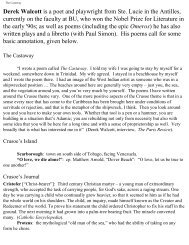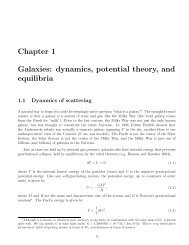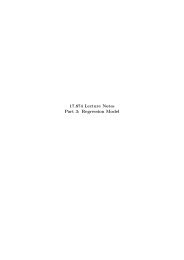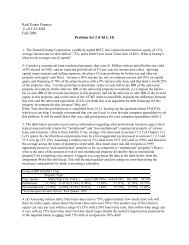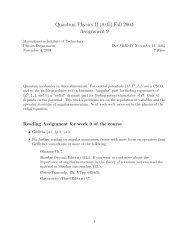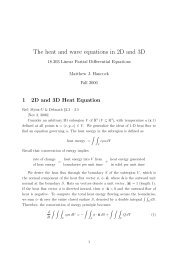18.02 Problem Set 1
18.02 Problem Set 1
18.02 Problem Set 1
You also want an ePaper? Increase the reach of your titles
YUMPU automatically turns print PDFs into web optimized ePapers that Google loves.
<strong>18.02</strong> <strong>Problem</strong> <strong>Set</strong> 1Due Thursday 9/13/07, 12:45 pm.<strong>18.02</strong> Supplementary Notes and <strong>Problem</strong>s. This is where to find the exercises labelled 1A, 1B,etc.<strong>Problem</strong> <strong>Set</strong>s have two parts, A and B.Part A has problems from the text, with answers to many in the back of the text, andproblems from the Notes with solutions at the end of the Notes. Look at the solutions ifyou get stuck, but try to do as much as possible without them. Hand in the underlinedproblems only; the others are for more practice. Part A will be graded quickly, checkingthat the problems are there and the solutions not merely copied.Part B consists of unsolved problems, is worth more points, and will be graded morecarefully. Many of these problems are longer multi-part exercises posed here because theydo not fit conveniently into an exam or short-answer format.Advice: Make sure that you understand the problems by comparing your answersagainst the solutions, whether before (Part A) or after (Part B) the assignment is due.Keep up with the work in small installments – don’t leave it all for a marathon sessionon Wednesday night. You can’t learn well under time pressure. To help you keep up,each problem is labelled with the day on which you will have the needed background for it.Homework Rules: Collaboration on problem sets is encouraged, buta) Attempt each part of each problem yourself. Read each portion of the problembefore asking for help. If you don’t understand what is being asked, ask for help interpretingthe problem and then make an honest attempt to solve it.b) Write up each problem independently. On both Part A and B exercises you areexpected to write the answer in your own words.c) Write on your problem set whom you consulted and the sources you used.If you fail to do so, you may be charged with plagiarism and subject to serious penalties.d) It is illegal to consult materials from previous semesters.Part A(15 points)Hand in the underlined problems only; the others are for more practice.(Notation: 12.1/17 = Book, Section 12.1, problem 17; 1A/1 = Suppl. Notes, page 1A,problem 1).Recitation. Wed Sept. 5 Introduction to vectors: addition, scalar multiplicationRead: 12.1Work: 12.1/ 17, 23, 45; 1A/ 1, 5, 6, 7, 8, 9, 11.Lecture 1. Thu Sept. 6 Dot productRead: 12.2Work: 1B/ 1, 2, 5ab, 11, 12, 13, 14.Lecture 2. Fri Sept. 7 Determinants, cross productRead: Notes D, Book 12.3Work: 1C/ 1, 2, 3, 5a, 6, 7; 1D/ 1, 2, 3, 4, 5, 7.Lecture 3. Tue Sept. 11 Matrices and inverse matricesRead Notes M.1, M.2 (pp. 1–7)Work: 1F/ 5ab, 8a, 9; 1G/ 3, 4, 5.1
Part B(27 points)Directions: Attempt to solve each part of each problem yourself. If you collaborate,solutions must be written up independently. It is illegal to consult materials from previoussemesters. With each problem is the day it can be done.Write the names of all the people you consulted or with whom you collaborated andthe resources you used, or say “none” or “no consultation”. This includes visits outsiderecitation to your recitation instructor. If you don’t know a name, you must neverthelessidentify the person, as in, “tutor ”, “the student next to me in recitation.”Optional: note which of these people or resources, if any, were particularly helpful to you.<strong>Problem</strong> 1. (Thursday, 5 points: 2+1+1+1)The eight vertices of a cube centered at (0,0,0) of side length 2 are at (±1, ±1, ±1).a) Find the four vertices of the cube, starting with (1,1,1), that form a regular tetrahedron.Confirm your answer by finding the length of an edge and explaining why all edgeshave the same length.b) A methane molecule consists of a hydrogen atom at each of the vertices of a regulartetrahedron and a carbon atom at the center. Find the “bond angle”, i.e. the angle made byvectors from the carbon atom to two hydrogen atoms (use a calculator; round your answer).c) Use dot product to find the angle between two adjacent edges (sharing a commonvertex) of the tetrahedron; and the angle between two opposite edges. Explain your answersusing symmetry.d) (Friday) Find the area of a face of the tetrahedron.<strong>Problem</strong> 2. (Thursday, 3 points: 1+1+1)Consider a triangle in the plane with vertices P 1 , P 2 , and P 3 .a) Let v 1 , v 2 and v 3 be the vectors in the plane from the points P 1 , P 2 and P 3 respectivelyto a point P. Express in terms of the dot product and these three vectors the condition thatP is on the altitude of the triangle P 1 P 2 P 3 from the vertex P 1 . (By altitude we mean theentire line through a vertex perpendicular to the opposite side, not just the segment fromthe vertex to the side.)b) Assume that P is at the intersection of the altitudes from P 1 and P 2 . Show thatv 1 · v 2 = v 1 · v 3 = v 2 · v 3 .c) Under the assumptions in (b), show that P is also on the altitude from P 3 . (Henceall three altitudes meet in one point, called the orthocenter.)<strong>Problem</strong> 3. (Friday, 3 points)Four vectors are erected perpendicularly to the four faces of a general tetrahedron. Eachvector is pointing outwards and has length equal to the area of the face. Show that the sumof these four vectors is 0.Hint: let A, B and C be vectors representing the three edges starting from a fixedvertex. Express each of the four vectors in terms of A, B and C, and show that their sumis the zero vector; do not introduce a coordinate system.<strong>Problem</strong> 4. (Tuesday, 9 points: 1+2+2+2+2)Orthogonal matrices are matrices A that satisfy the identity AA T = I (I is the identitymatrix). An equivalent definition of the orthogonal matrix property is that A T A = I2
ecause the left and right inverses of a square matrix are the same (see 1G-9b). Theequation AA T = I says that the rows of A are perpendicular to each other and of unitlength, whereas the equation A T A = I says that the columns of A are perpendicular toeach other and of unit length. The geometric significance of orthogonal matrices is thatmultiplication by an orthogonal matrix preserves lengths of vectors and the absolute valuesof angles between them:|Av| = |v| and |̸ (Av,Aw)| = |̸ (v,w) | .There are two types of orthogonal matrices, rotations and reflections.a) In 2-dimensional space, rotations are given by( )cos θ −sin θA θ =sin θ cos θFind u = A θ î and v = A θ ĵ, and draw a picture of u and v for θ = π/4.b) Use the addition formulas for sine and cosine to deduce that A θ1 A θ2 = A θ1 +θ 2. Sayin words what this matrix formula means about rotations.c) Calculate A −1 Tθ, and use this to verify that A θ A θ= I (in other words, rotations areorthogonal matrices). Also verify that A − 1θ= A −θ , and give a geometric reason why thisproperty holds.d) Find the four orthogonal 2 × 2 matrices with first entry a 11 = −1/ √ 2. Hint: trydifferent signs. (See 1F-9 and 1F-10).e) Next to each of the matrices in your list in part (d), draw what the matrix does tothe letter F in the plane. Explain how the sign of the determinant of the matrix is relatedto the appearance of the transformed F.<strong>Problem</strong> 5. (Tuesday, 7 points: 1+2+2+2)Cookies, doughnuts, and croissants contain essentially the same ingredients (flour, sugar,egg, butter) but in different proportions. For example, it takes 22 grams of flour to make acookie, versus 40 g for a doughnut and 50 g for a croissant. The compositions of the variouspastries can be encoded in a 4 × 3 matrix,⎛ ⎞22 40 5018 10 3 M = ⎜ ⎟⎝ ,5 14 5 ⎠10 10 22where the entries in the i-th row represent the amounts of ingredient i (i = 1 for flour, 2 forsugar, 3 for egg, 4 for butter) required to make the various types of pastries.a) Consider an assortment of x 1 cookies, x 2 doughnuts and x 3 croissants, and form thecolumn vector ⎛ ⎞x 1X = ⎝ x 2⎠ .x 3What do the entries of the vector MX correspond to?b) Each of the four ingredients has a specific nutritional value: for example, 100 gramsof flour contain 10 g of protein, 76 g of carbohydrates, and 1 g of fat. Proceeding similarlyfor all four ingredients, we can build a 3 × 4 matrix,⎛⎞0.10 0 0.13 0N = ⎝ 0.76 1.00 0.01 0 ⎠ ,0.01 0 0.10 0.823
where the entries in the i-th column represent the proportions of protein, carbohydrates andfat in ingredient i.Give a matrix formula for the total nutritional value of the assortment of pastries consideredin (a). (Keep your answer in symbolic form, do not evaluate numerically.)c) Give a matrix formula expressing the numbers x i of pastries of each type which willadd up to y 1 g of protein, y 2 g of carbohydrates, and y 3 g of fat. Express your answer inthe form X = AY , and give both a formula for A and numerical values for its entries (useeither a calculator or Matlab; short directions for Matlab can be found on the course webpage in the Assignments section.d) The recommended daily amounts of protein, carbohydrates and fat for a 2000 caloriediet are 50, 300, and 65 grams respectively. If you wanted to follow those guidelines whileeating only cookies, doughnuts, and croissants, how many pastries of each type should youeat daily? What is wrong with your answer? Explain.4




